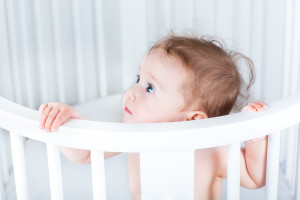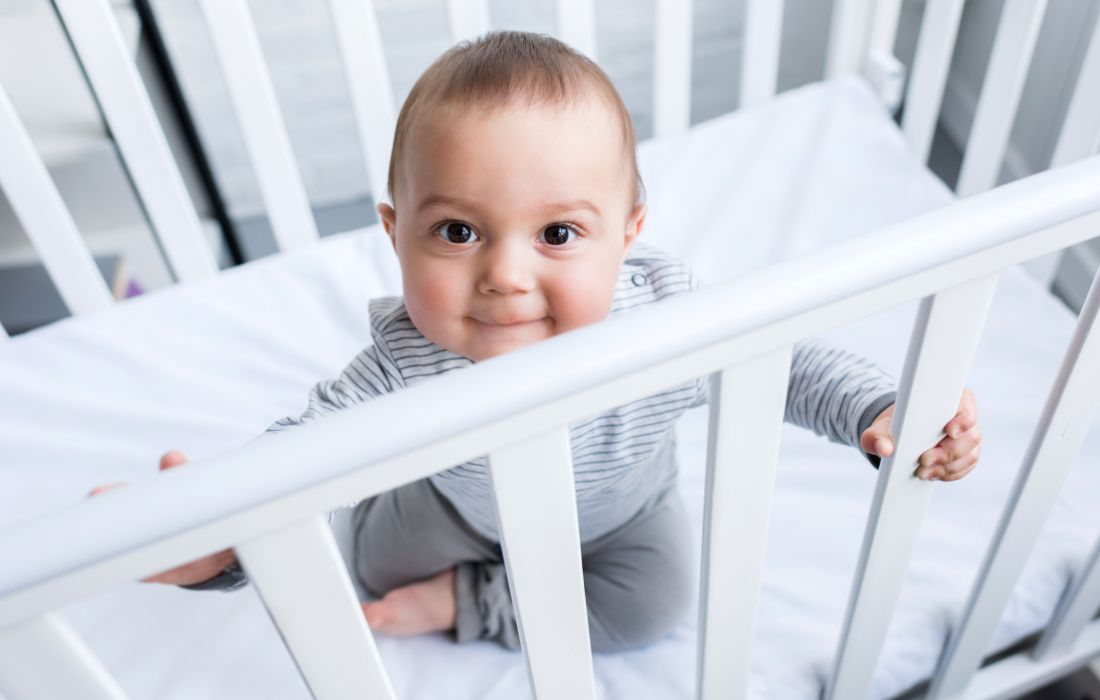That moment when you put your children into bed and there’s silence. You have a moment of panic , and then realize that your children are actually sleeping! Yes, sleeping.
If you have not had that experience yet, then you may need to put a few of my best baby sleep tips into action:
A Soothing, Predictable Bedtime Routine
Having a soothing, predictable routine is key in helping to communicate the need to prepare for sleeping. This familiar set of events says to your baby, “It’s time to slow down and get ready for sleep.”
Keep the routine simple with 2 or 3 activities and keep doing those activities in the same order each night. The total routine should last 20 to 30 minutes and include something your baby or toddler finds enjoyable and relaxing. Some suggestions might include a bath, soft music or lullaby, snuggles, or a bedtime story.

A Lovey, Blanket, or Pacifier
By the time your baby is 5 or 6 months old, you may notice they have figured out a variety of ways to soothe themselves. Perhaps your baby took to a pacifier early on and will only sleep with their binky or your little one is more of a naturalist and prefers sucking on their fingers or thumb.
If your baby is still struggling to go to sleep on his or her own or waking during the night and having a hard time falling back asleep, it may be time to introduce a comfort object. This may be a small blanket or lovey or it could be a small stuffed toy your baby can hold in his or her hands.
Once you and your little one figure out which comfort object is right for them, make sure you have at least 2 just in case something would happen to this special item.
Bedroom is conducive to sleep
Your little one’s bedroom is their sanctuary, their place away from the busy days of visiting relatives and toys with bright lights and lots of sounds. Keep your baby’s bedroom soft and neutral with pale walls and no stimulating toys or mobiles near the crib.
Have the main light on a dimmer for bedtime or use a lamp to instill the feeling that is it time to slow down and prepare for sleep. Be mindful that the temperature in the room is neither too warm nor too cool.
Quality and quantity both matter
 When it comes to baby sleep, it is important for your baby to get enough sleep as well as uninterrupted and motionless sleep. Depending on the age of your little one, they need a certain amount of sleep each day and night for optimal health.
When it comes to baby sleep, it is important for your baby to get enough sleep as well as uninterrupted and motionless sleep. Depending on the age of your little one, they need a certain amount of sleep each day and night for optimal health.
This means sticking to consistent bedtimes and wake up times, and trying to keep nap times about the same each day. It is important to not deviate more than 1 hour from the recommended quantity of sleep for your age baby.
Strive to give your baby the best quality of sleep as possible, meaning as long as they need, without interruptions and while lying still in a crib or basinet, not while in motion in the car, stroller, or swing.
Be consistent
Easier said, than done! Being consistent is probably one of the most common pieces of advice given to any parent on any number or parenting issues. Consistency in sleep coaching is paramount and the lack of consistency can result in intermittent reinforcement of sleeping problems.
Decide on a plan and what your response will be to nighttime awakenings and stick to it. Make sure all caregivers are on the same page. Babies and children actually crave consistency because it helps them to feel safe and secure.
Early bedtime
If you have been keeping your baby awake later in the hopes that he or she will sleep longer, you are actually programming your baby to wake earlier! It seems counter intuitive but an early bedtime leads to better and longer nights of sleep for babies.
Once your baby is past the infant sleep stage (around age 6 months), a biologically appropriate bedtime is around 7:00 pm. A good rule of thumb is to make bedtime 2 hours post dinner (solids). As always be mindful of your child’s wakefulness windows and pay attention to their sleepy cues.
Pay attention to your child’s drowsy cues
When is the right time to lay your baby down to sleep? This is an interesting question and the answer is not what you may think. Many parents rock or snuggle their baby until they are sleeping soundly, and then place them in their crib, creeping out of the nursery holding their breath.
 And then it happens- the scream, the cry, the heartbreak! It is possible to put your baby in their crib too far gone on the sleepiness scale. You will hear the expression “drowsy but awake” throughout Good Night Sleep Tight and the articles on sleeplady.com.
And then it happens- the scream, the cry, the heartbreak! It is possible to put your baby in their crib too far gone on the sleepiness scale. You will hear the expression “drowsy but awake” throughout Good Night Sleep Tight and the articles on sleeplady.com.
This means your baby is quite sleepy but aware of going in the crib. It is essential that your little one learn to do the last part of falling asleep on their own by figuring out what feels good and relaxing to them.
Stick to a schedule
Having a predictable daily schedule that includes your bedtime routine is very important for creating a feeling of security and comfort for your baby. Keeping the daily schedule for your little one flexible (activities can vary by ½ hour earlier or later) but predictable enables your baby to know what to expect throughout the day and at night as well.
Let’s face it- life happens! Sometimes despite the best of intentions, somehow a monkey wrench gets thrown into your schedule and the day gets turned on end. Take a deep breath and refocus to get back on your regular schedule the next day.
Make the crib a safe place
In order for your baby and you to get the best night’s sleep possible it is absolutely imperative that you carefully review best practices in making your baby’s crib a super safe place. For up to date information, check the American Academy of Pediatrics (AAP) website or talk with your pediatrician.
Some commonly cited best practices include using a new firm mattress with a tight fitting crib sheet, putting baby to sleep on their back, keeping all stuffed items, blankets, quilts, pillows, etc. out of the crib, and offering a pacifier, especially if your baby is younger than 6 months old.
Be prepared for sleep regressions
Know that temporary hiccups along the way to your baby sleeping soundly through the night are normal. Despite staying incredibly consistent with sleep coaching your baby, helping them learn to self soothe, allowing them the opportunity to learn how to sleep on their own, and supporting them with love and patience all the while, sleep regressions happen.
It is very common for these periods of interrupted sleep to co-occur with cognitive and developmental milestones. Just remember that “this too shall pass” and stay the course!







